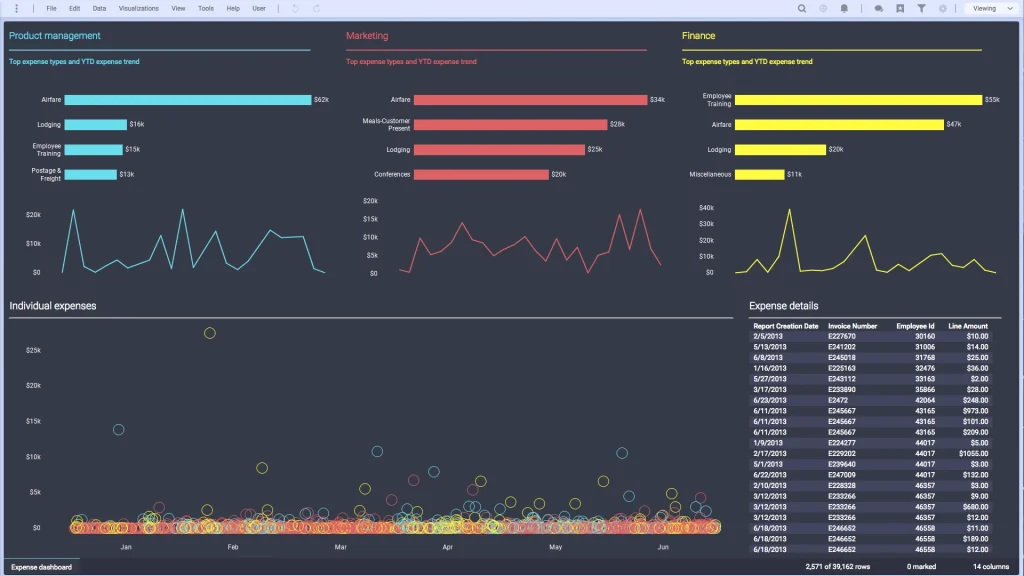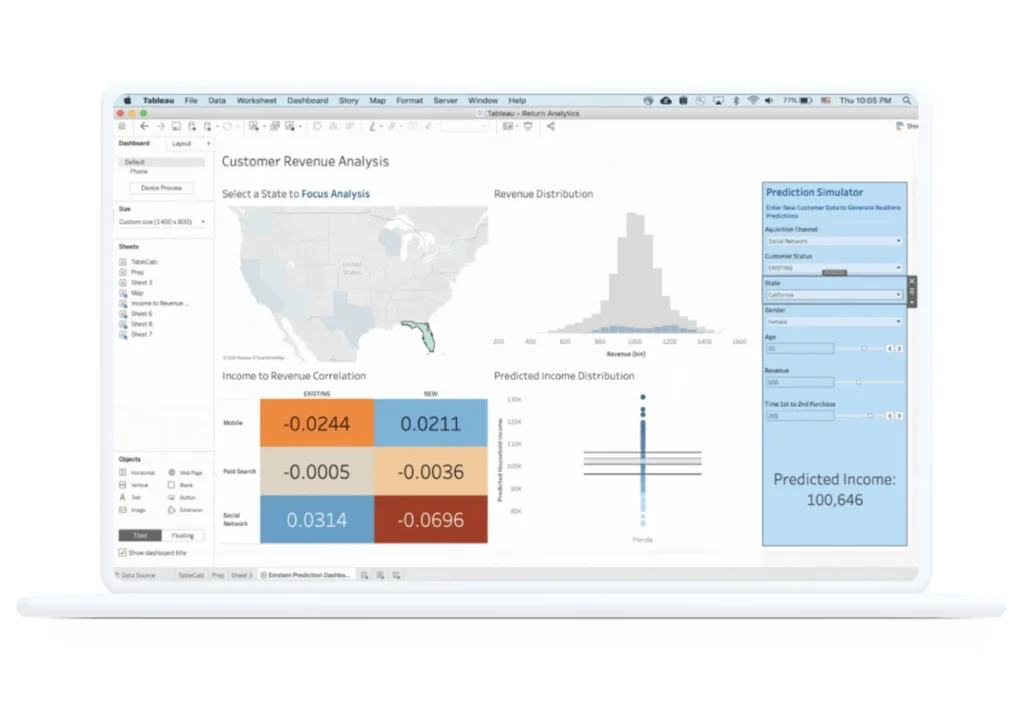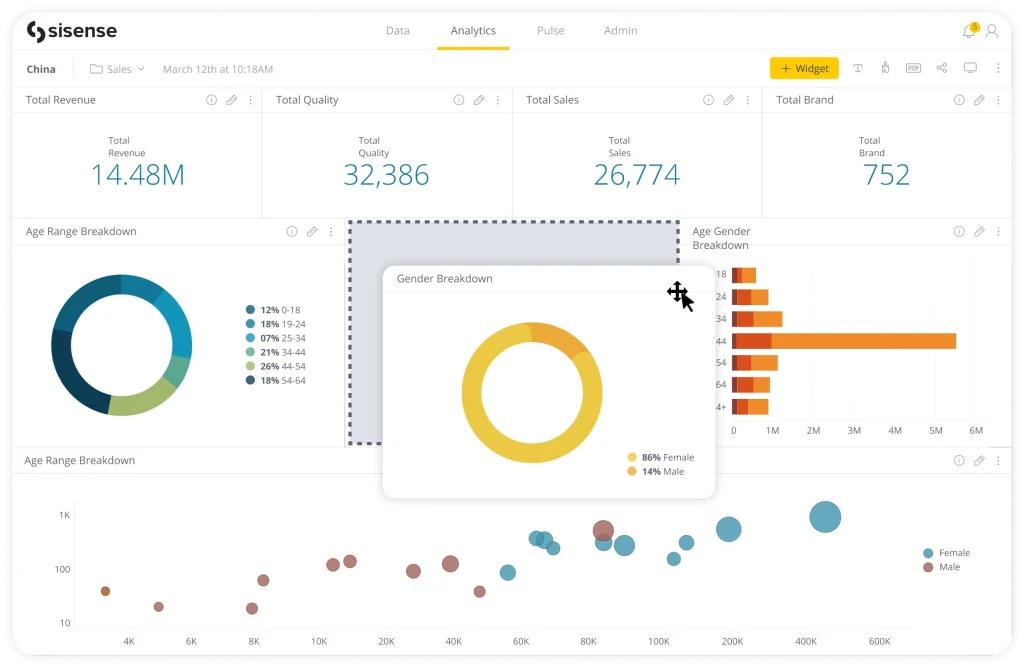However, it is always a challenge here for any retailers to choose the most suitable retail analytics software at the least pricing plan (if possible) for their own business. As we all know, retailers want to make the most profit with an optimized cost.
So here it is. This article is well curated to cover some of the best retail analytics software & tools that can help you, as retailers, decide which one is the most fitting. Then, you can leverage it to optimize your business operations, increase sales and enhance the customer experience in 2025.
Some of the best retail analytics software & tools in 2025
1. TIBCO Spotfire
TIBCO Spotfire is undeniably one of the best retail analytics software for both newcomers and veteran vendors. It is a powerful, multi-functional and seamless data analytics tool to use and adapt. This software can help small businesses, retailers and corporations gain in-depth customer insights, therefore, decide the best solutions and strategies based on the mass-collected information.
TIBCO Spotfire offers a variety of features, notably the TIBCO Hyperconverged Analytics that can provide real-time business insights through visual analytics, data discovery, geoanalytics and interactive embedded data science. Businesses can have the all-in-one data-driven retail experience when using TIBCO Spotfire, optimizing the workflow and creating the best business strategy in the future.

Some of the pros and cons of TIBCO Spotfire can be listed below:
Pros:
- The learning curve is easy to follow; therefore, it can be approached by multiple types of businesses: lone retailers, SMBs, big corporations, multinational companies and so on.
- Offering configurable interfaces tailored to the business’s needs.
- An immense amount of customer-centric data can automatically be updated in real-time.
Cons:
- Having an all-in-one interface can sometimes be a downside, as the needed features can be complicated for newcomers to navigate.
- GeoAnalytics feature can be complex for retailers to use and fully optimize all integrated functions.
2. Tableau Desktop

Regarding data visualization and offline analysis, Tableau Desktop should be the first one that pops up in your head. This retail analytics software can deliver intuitive, accessible and detailed customer data through user-friendly dashboards. Therefore, retailers can gain real-time insights and make data-driven decisions in their product-centered operations.
The most outstanding feature of Tableau is the ability to interact with data catalogs through a drag-and-drop motion visually. It’s highly suggested that SMBs and non-tech businesses integrate this software into their retail stores, as this requires zero coding experience and less time to check up due to the offline progress-saving feature.
Some of the pros and cons of Tableau Desktop can be listed below:
Pros:
- The drag-and-drop feature assists businesses with intuitive and multi-functional features without needing technical knowledge and coding experiences.
- Multiple data visualization options – including trend lines, statistical analysis and forecasting dashboards.
- Flexible to multiple data sources: sheets, cloud-based documents and other databases.
Cons:
- The learning curve can be steep for newcomers and lone retailers due to multiple functions that can be hard to navigate.
- The data versioning is poor – you can’t get back to retrieve the old data when new dashboards are published.
3. BOARD
BOARD is considered one of the most used retail analytics software for both newbies and veterans in the world of retail. With BOARD, you can easily optimize your retail strategies through the latest business intelligence technologies, turning customer buying trends into profitable strategies and products and tailoring for potential and targeted customers.
The features that BOARD can offer for businesses are limitless – and the Intelligent Planning feature is the most prominent. When using BOARD, businesses and retailers will be supported with updated, unified and real-time data, assisting them in planning the next steps for the whole product campaign and the potential branch of customers.
Some of the pros and cons of BOARD can be listed below:
Pros:
- The learning curve is shallow with a comprehensive toolbox approach; therefore, it can be approached by multiple types of businesses.
- An all-in-one interface includes reports with graphs and valuable objects to represent the needed information.
- Low total cost ownership for anyone – from small businesses to international corporations.
Cons:
- The data view is limited by the number of rows – which can be difficult for retailers when they want to analyze multiple criteria.
- Grouping and max/min functions are designed in cubes, which can be challenging for newcomers to configure.
4. Looker
One of the best business intelligence and retail analytics software in the past few years – Looker is widely used by new retailers and SMBs, due to its usability and transparency. This tool includes an intuitive interface for exploring data, a reusable development approach for data discovery, and an API that supports other data-driven sources.
Retailers widely know Looker as Looker Studio – one business intelligence branch that assists retail businesses with streamlined data and real-time customer approaches. Having multiple customized interfaces, Looker Studio can tailor the information that fits the users’ needs, including visualization charts, listed tables and group reports, which can be shared only by the dashboard owners.
Some of the pros and cons of Looker can be listed below:
Pros:
- The interface is easy to use and approach, perfect for newcomers and SMBs.
- The level of customization is limitless. You can allow multiple charts and tables to be visible in your dashboard, assisting in your business analysis and decisions.
- Having a free option available – anyone can use Looker as the starting point.
Cons:
- The data listed on Looker dashboard may sometimes need to be updated and even false due to a lack of filtering real-time customer approach.
- Lagging and downtimes may happen if putting too much information, therefore not suitable for multinational and international businesses.
5. Sisense
Sisense is the leading retail analytics software specializing in embedded analytics to help retailers and businesses perform product campaigns in the most streamlined workflow. Moreover, this tool can customize experiences for tech and non-tech retailers with code-first, low-code, and no-code interfaces for business optimization and product-based strategies.
Using Sisense means you get to use a three-in-one solution: Infusion Apps function helps you to acquire the insights you need for your product through users’ data; Fusion Analytics helps you to create the most relevant experiences tailored for each category of your product; Fusion Embed enables the integration of customized analytics experiences seamlessly into your applications and workflows at scale.

Some of the pros and cons of Sisense can be listed below:
Pros:
- The interface is easy for both newcomers and veteran retailers to navigate and arrange the data dashboards.
- The data delivery capability is seamless and fast, even with multiple data sources.
- The drag-and-drop feature helps businesses create functional data-driven dashboards without knowing much about technical knowledge.
Cons:
- The dashboard-sharing feature can sometimes be hard to navigate and use, especially for newbies.
- The filtering function on mobile devices (cellphones, tablets) is not fully optimized.
6. Microstrategy analytics
Microstrategy Analytics is considered one of the best retail analytics software to assist retail corporations and enterprises in data analysis and digital security. This tool’s design of innovative business intelligence, influence, and intelligent workflows has made data-driven dashboards much easier to analyze and navigate.
One of the best features of Microstrategy Analytics that should be mentioned is MicroStrategy ONE. Claimed to be the most complete and comprehensive analytics system, this tool has everything to cover: from business reporting and embedded data, this platform can help retailers to get a total view of the business, hassle-free, informative and personalized.
Some of the pros and cons of Microstrategy Analytics can be listed below:
Pros:
- The interface is friendly to PC and mobile users; therefore, retailers can track and analyze their data anywhere.
- Retailers can have massive data integrated into a single dashboard without downtime.
- Multiple customization dashboards can be performed based on the needs of each product.
Cons:
- The learning curve is quite steep, which makes it difficult to follow at first hand.
- Pricing options are slightly more expensive than other retail analytics software, which may prevent SMBs and new retailers from using.
7. Lightspeed Retail
As its name implies – Lightspeed Retail is the platform that solely focuses on helping retailers manage their inventory, keeping track of the production process and analyzing data through real-time shopping conductions. Moreover, retailers using this tool can check their stocks at any time of the day because of the mobile-supported interface.
The core of Lightspeed Retail lies in the POS (Point-of-sale) system, which can cover anything on-spot. From suppliers, channels and stores to customer information, this platform can cover them in a single data-driven dashboard, which helps retailers to manage and track the needed information. As a result, users can effectively plan for other steps of the product life cycle.
Some of the pros and cons of Lightspeed Retail can be listed below:
Pros:
- The POS system interface is easy for newcomers and veterans to manage and interact with a drag-and-drop mechanism.
- It offers 24/7 customer service, so it’s perfect for retailers to use and adapt.
Cons:
- The pricing options and user requirements are high for small retailers and SMBs.
- The analytics and inventory feature is relatively shallow for enterprise-sized businesses and big retailers, as the table of contents is limited.
8. TripleWhale
TripleWhale is developed for small retailers and SMBs to track and analyze key metrics crucial to the business through ads and sales data. This retail analytics software can also distribute consumer interactions to the relevant platforms used by businesses, creating an all-in-one, easy-to-interact and seamless solution.
The key feature that contributes to the emergence of TripleWhale is the Triple Whale Pixel. This built-in solution can track consumer purchases on your POS and allows retailers to follow each step of the customer’s buying journey. The key performance indicators (KPI) dashboard can be tracked and followed in real-time, including orders, conversions, return on ad spend, etc.
Some of the pros and cons of TripleWhale can be listed below:
Pros:
- The mobile-friendly interface makes it easy for retailers to track and manage customer interactions in real-time.
- Customizable dashboards are integrated, tailored to the users’ needs.
- The forecasting calculator feature allows users to run simulations depending on the data, therefore helping users to forecast the following buying trends.
Cons:
- The cost of this tool can be thrifty for new retailers and start-ups.
- The store should be run on Spotify to connect to the feature of this software; therefore, stores running on other eCommerce platforms are not compatible.
9. Numerator insights
Being widely recognized as one of the most influential retail analytics software for brands and retailers, Numerator Insights focus on finding the appropriate customer insights through data-driven dashboards. Therefore, retail businesses can find the perfect solution to solve market-related problems and create the best strategy for the whole product life cycle.
Numerator Insights’ features are varied, notably the Numerator OmniPanel. This built-in solution can provide retailers and brands with multiple tables of contents integrated into a single dashboard. Moreover, those dashboards can be tailored to the user’s liking, contributing significantly to the tracking and analyzing process.
Some of the pros and cons of Numerator Insights can be listed below:
Pros:
- The competitor tracking function makes it easy for retailers to see and analyze what others are doing, their success, and what users can implement into the product strategy.
- The interface is easy to navigate and arrange due to the drag-and-drop motion.
Cons:
- The sample size for insight analysis can be pretty shallow for enterprise-sized retailers, as there will be more data to assess than for small and medium-sized businesses.
- The learning curve can be a little steep for newcomers and small retailers.
10. Flame Analytics
Flame Analytics is the ultimate retail analytics tool for geographical analysis and consumer journey tracking. This retail analytics software is perfect for retailers and SMBs, as the feature of combining video and other data sources is easy to use and interact with, helping them maximize visitors’ value and the performance of the POS system.
The most outstanding feature of Flame Analytics is the ability to track the location’s performance through customer interactions. Using this tool, retailers can track the number of client visits, both online and offline. Therefore, users can fully optimize both the product and sales strategy based on data-driven dashboards.
Some of the pros and cons of Flame Analytics can be listed below:
Pros:
- The collection of location-based data is limitless, allowing retailers to understand each potential customer group’s behavior deeply.
- The interface is easy for users to navigate and access; therefore, businesses of all sizes can use it effectively.
Cons:
- The learning curve can be too steep for businesses with little data sources or zero knowledge of data analysis.
- The pricing options can be a little high for retail newbies.
Frequently asked questions (FAQs)
Most retail analytics software can assist you in finding customers’ insights and building the appropriate sales or product development strategy. However, there are some other criteria to include, which can be listed below:
– Automated and personalized competitor analysis: This is crucial to retailers, as you might want to know why and how those competitors’ data and strategies can affect the sales of the related product.
– The data should be as detailed as possible: Tracking and analyzing customer data is essential, as this could affect the product and sales strategy.
– Forecasting trends: This function should be included in your chosen retail analytics software to assist you in every customer purchasing scenario, deciding the best sales and marketing steps.
– Automated updates: This is the needed feature for pricing options, product updates, and real-time customer journey tracking.
– Cross-selling recommendations: As the scale of your retail brand increase, so will your customer. Therefore, it’s highly recommended that new and potential customers be introduced to your product immediately and vice versa.
There are other options if you don’t want to use the available automated analytics tools. For example, outsourcing a professional tech team to develop a data analytics system is a great idea to get them suit the specific needs of your retail business.
And Synodus might be a good outsourcing tech agency to choose regarding our diverse tech stack and extensive experience working with retailers worldwide. We can assist them in making a name for themselves and outperforming competitors through omnichannel solutions, market intelligence, automation software. Also, we make it a priority to understand your business context first and only design projects that are feasible and fit your goals.
For more information, please visit our Data Analytics Services. Don’t hesitate to contact us for further discussion.
Final words
Opting for a retail analytics software and tool has never been a bad idea if you understand how to leverage it to answer whatever questions you have to better your retail operations, gain more insights so you can be much better at serving your customers. Yet, keep in mind that you should have a deep understanding of the products, their features, their pros & cons to choose the most suitable one.
Don’t forget that, Synodus, as a one-stop tech partner, is here to help you if your business are struggling with data and more.
How useful was this post?
Click on a star to rate it!
Average rating / 5. Vote count:
No votes so far! Be the first to rate this post.




